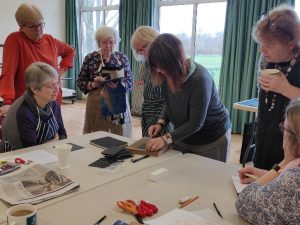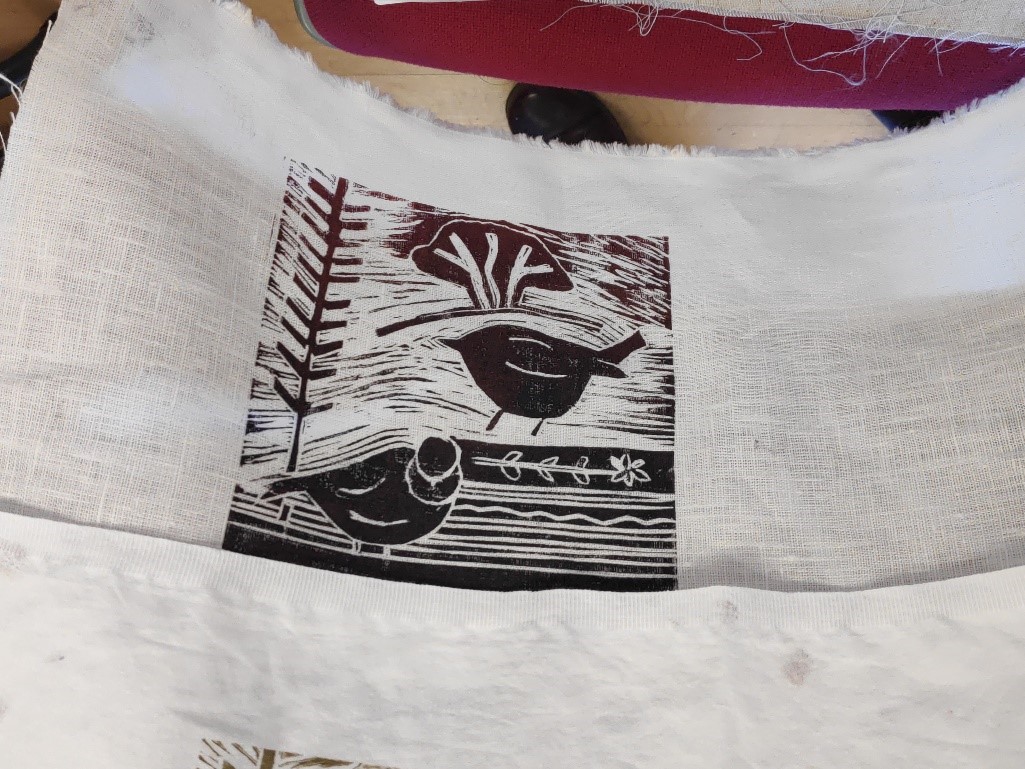Louise Nichol - Lino Printing on Fabric

Louise first introduced herself as a textile artist and she doesnu2019t class herself as a printmaker.
She talked us through the process which we would be going through on this one day workshop. Today is all about getting the fabric printed with a design that then can be embellished, appliqued, or embroidered to our own unique style to produce an item that can either be used for fashion, accessories or fine art.
She uses a singular linou00a0 block with one colourway print or on a rare occasion a multiblock print of more than one colour combination .
When choosing a design Louise advised that not too much detail is the key to being able to add future applique, embellishments etc,u00a0 so that we are not constricted by fine detail on the fabric or which would be lost if we were to cover up inadvertentlyu00a0 e.g.u00a0 less area for further enhancements with thread, appliqued fabrics etc.u00a0
We measured out a design roughly 6 inch square or similar area in a rectangle as this would be a suitable amount to carve and print in the time available.u00a0
u00a0

We then proceeded to carve out the design which was fairly successful on the softcut lino Louise provided u2013 (softer and easier to carve than traditional lino) before making sure that any lines were not too finely carved together as when you print onto fabric sometimes the ink can be transferred to the carved out lines if not thick enough and therefore losingu00a0the detail of the print.u00a0u00a0
Once carving was complete after lunch Louise advised aboutu00a0suitable fabrics to print upon.u00a0
Closely woven fabrics would take the print well but you needu00a0to remember that it is sometimes harder to put a needle through a tightly wovenu00a0fabric and the addition of printed ink on top of the fabric can make sewingu00a0harder still. So a smooth finished fabric such as linen with a looser weave would be ideal or similar cotton fabrics.u00a0

u00a0
With regards to which ink to use for printing our fabric it really depended upon whether we would be intending to wash the item after completed. Louise brought 2 different fabric block printing inks with her, a watercolour one which is light fast and suitable for fine art pieces which do not require washing (in fact if you were to wash would be ruined as the ink would be removed) or a Speedball fabric ink which was oil based, which takes longer to dry and needs fixing with an iron (and a piece of parchment paper to protect the iron) but once fixed can be safely washed so is suitable for fashion items.u00a0
u00a0



We spent the rest of the afternoon experimenting with theu00a0different inks in a variety of colour ways on a selection of fabrics.u00a0
Louise then advised that to finish off the item , you would back the item with either a lightweight fusible interfacing or a bondaweb sheet and depending upon your use, a lightweight wadding etc before embroidering or appliqueing the item.u00a0
u00a0



Report and photos by Claire T.
Thank you Claire, Ros
